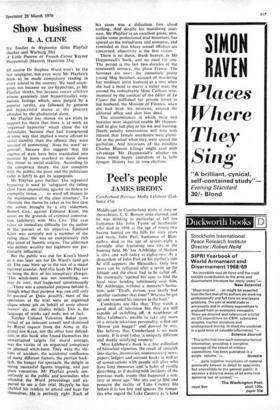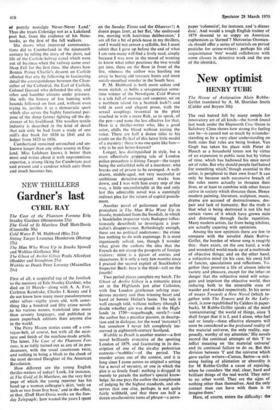Peel's people
JAMES BREDIN
Cumberland Heritage Molly Lefebure (Gol- lancz 45s) Middle-age in Cumberland starts at sixty or thereabouts, C. E. Benson once claimed, and he was thinking in particular of fell fox huntsmen like John Tyson of Seathwaite who died in 1698 at the age of ninety-two having hunted on the fells for sixty years and more. John Peel, huntsman of Blen- cathra, died at the age of seventy-eight a fortnight after fracturing two ribs in the hunting field. Mr Joe Ashbridge of Skelton is alive and well today at eighty-two. As a descendent of John Peel on his mother's side he still supports the Blencathra. Only two years ago he collapsed after a sprint up the fellside and the chase had to be called off. He eventually 'opened his eyes to find the local vicar bending solicitously over him. Mr Ashbridge, without a moment's hesita- tion, said "Eh-eh, parson, you nearly had another customer that time!" Whereat he got up and resumed his interest in the hunt.'
Cumbrians are like that. They watch a good deal of television but they are still capable of switating off. A neighbour of Miss Lefebure's, unable to take any more of a certain television personality, called out 'Dowse yan bugger!' and dowsed he was. She believes that Cumberland is no mere county. It is even today 'a uniquely different and deeply satisfying country.'
Miss Lefebure's book is a fine collection of historical vignettes, the result of research into diaries, inventories, contemporary news- Tapers, ledgers and account books as well as of conversations with people still alive who have long memories and 'a habit of vividly describing, as if dealing with incidents of the previous week, events that happened a cen- tury or more ago.' She sets out to find and preserve the reality of Lake Country life before it is too late and ignores the roman- tics who regard the Lake Country as 'a kind
of prettily nostalgic Never-Never Land' Thus she treats Coleridge not as a Lakeland poet but, from the evidence of his Note, books, as the first of the fell walkers.
She shows what improved communica- tions did to Cumberland in the nineteenth century by telling the story of the short, sad life of the Carlisle-Solway canal which went out of business when the railway came over Shap Fell for the first time. She shows how Bonnie Prince Charlie's descent on Carlisle affected that city by following in fascinating detail the correspondence between the Chan- cellor of the Cathedral, the Earl of Carlisle, Colonel Durand who defended the city, and other and humbler citizens under pressure. She tells the history of fox hunting with hounds followed on foot and, without even trying to, justifies it as a democratic sport which also serves the highly functional pur- pose of the sheep farmer fighting off the de- stroyer of his livelihood. The woollen textile industry is described in the kind of detail that can only be had from a study of one mill's day book for 1830 to 1841 and its ledger from 1823 to 1856.
Cumberland remained untouched and un- known longer than any other county in Eng- land. Miss Lefebure knows it better than most and writes about it with unpretentious expertise, a strong liking for Cumbrians past and present and a candour which suits them and much becomes her.



































 Previous page
Previous page